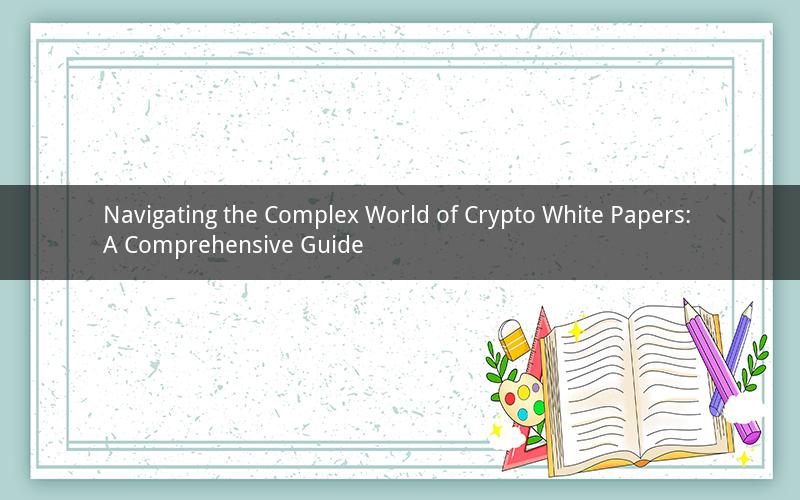
In the rapidly evolving cryptocurrency landscape, understanding white papers has become a crucial skill for both investors and developers. A white paper serves as a foundational document that outlines a project's objectives, technology, and implementation details. This article will delve into how to read a crypto white paper effectively, offering insights into its key components and highlighting important aspects to consider.
Understanding the Purpose of a White Paper
A white paper is designed to provide a comprehensive overview of a cryptocurrency project. It serves multiple purposes, including:
1. Introducing the project: A white paper presents the core concept, objectives, and goals of the project, enabling readers to understand its value proposition.
2. Describing the technology: It explains the underlying technology, including the blockchain platform, consensus mechanism, and any unique features that set the project apart.
3. Detailing the tokenomics: White papers provide information on the distribution of tokens, their utility, and the economic model of the project.
4. Outlining the roadmap: The white paper typically includes a timeline for the project's development, helping readers gauge the progress and potential milestones.
5. Attracting investors: By offering detailed insights into the project, white papers aim to attract potential investors and foster community support.
Key Components of a Crypto White Paper
To effectively read a crypto white paper, it's essential to familiarize yourself with its key components:
1. The title should be clear, concise, and reflective of the project's purpose.
2. Abstract: The abstract provides a brief summary of the white paper, highlighting its key points and objectives.
3. Introduction: This section introduces the project, its background, and the problems it aims to solve.
4. Technology: This part describes the underlying technology, including the blockchain platform, consensus mechanism, and any innovative features.
5. Tokenomics: Here, the white paper outlines the token distribution, utility, and economic model of the project.
6. Implementation: This section details the project's roadmap, including milestones, timelines, and potential challenges.
7. Team: The white paper should provide information about the project's team members, their experience, and their roles within the project.
8. Community: Details on the project's community, including forums, social media, and events, are essential for assessing the project's engagement.
9. Risks and Challenges: A thorough discussion of potential risks and challenges helps readers gauge the project's viability.
10. Conclusion: The conclusion summarizes the white paper's key points and reiterates the project's value proposition.
How to Read a Crypto White Paper: A Step-by-Step Guide
1. Familiarize yourself with the project: Before diving into the white paper, research the project, its team, and its goals. This will help you better understand the context in which the white paper was written.
2. Start with the abstract: Read the abstract to get a high-level understanding of the white paper's objectives and key points.
3. Analyze the technology: Pay close attention to the technology section. Assess the project's uniqueness, its potential advantages, and any potential drawbacks.
4. Evaluate the tokenomics: Understand how the tokens are distributed, their utility, and the economic model. This will help you gauge the project's potential for long-term success.
5. Review the roadmap: Assess the project's timeline and milestones. Look for any unrealistic or overly ambitious goals that may raise red flags.
6. Examine the team: Research the team members, their backgrounds, and their experience. Look for relevant expertise and a history of successful projects.
7. Analyze the community: Evaluate the project's community engagement. An active and engaged community can be a positive sign for a project's long-term viability.
8. Consider the risks and challenges: Assess the potential risks and challenges mentioned in the white paper. Look for projects that are transparent about their vulnerabilities and have plans to address them.
9. Draw conclusions: Based on your analysis, draw conclusions about the project's potential and its viability as an investment or development opportunity.
10. Stay updated: Keep an eye on the project's progress and any updates to the white paper. This will help you stay informed and make more informed decisions.
Five Questions to Ask When Reading a Crypto White Paper
1. What is the unique value proposition of this project, and how does it stand out from competitors?
2. What is the team's experience, and does it align with the project's goals and technology?
3. How is the token distribution structured, and what is the project's economic model?
4. What risks and challenges does the project face, and how does the team plan to address them?
5. How active is the project's community, and does it indicate strong support for the project's long-term success?
By following this guide and asking the right questions, you can navigate the complex world of crypto white papers with confidence and make more informed decisions in the cryptocurrency market.